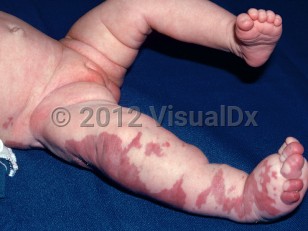Klippel-Trenaunay syndrome (KTS) is also known as hemangiectatic hypertrophy or angio-osteohypertrophy syndrome. Typically, hemihypertrophy, varicose veins, and capillary malformations (port-wine stains) are seen early in life. This triad may affect one or more extremity or the trunk, and it may more rarely affect the head or neck. If an extremity is affected, the resultant hemihypertrophy gives rise to increased limb girth and length. The syndrome is most frequently diagnosed in infancy or early childhood.
A capillary malformation that does not cross the midline of the body, is present at birth, or develops in early childhood. Varicose veins can be extensive, appearing not only below the knee but also in the pelvic region, often sparing the saphenous distribution. They may not be visible until the child begins to walk. Hypertrophy of one or more body parts is usually seen at birth and worsens during the first few years of life. This is due to hypertrophy of the soft tissues and sometimes bone. Lymphatic manifestations include lymphedema, lymphatic blebs, and pseudoverrucous papules. Usually one extremity (the leg more commonly than the arm) is affected. Truncal involvement may occur, and the head and neck are rarely affected. Rarely, multiple limbs may be affected.
KTS is considered a subtype of the PIK3CA-related overgrowth spectrum (PROS), which includes genetic disorders resulting in overgrowth due to mutations in the PIK3CA gene. Nevertheless, the exact etiology of KTS is not fully understood, and not all patients with this syndrome have the PIK3CA gene mutation.
Complications of KTS include thrombophlebitis, thromboembolism, and coagulopathy. Cutaneous complications include stasis dermatitis and venous stasis ulcers. Vascular malformations have been reported to occur internally as well; gastrointestinal (GI) bleeding may complicate GI tract malformations. Scoliosis may develop as a result of lower limb length discrepancy.
Klippel-Trenaunay syndrome in Adult
See also in: AnogenitalAlerts and Notices
Important News & Links
Synopsis

Codes
ICD10CM:
Q87.2 – Congenital malformation syndromes predominantly involving limbs
SNOMEDCT:
721105004 – Klippel Trenaunay syndrome
Q87.2 – Congenital malformation syndromes predominantly involving limbs
SNOMEDCT:
721105004 – Klippel Trenaunay syndrome
Look For
Subscription Required
Diagnostic Pearls
Subscription Required
Differential Diagnosis & Pitfalls

To perform a comparison, select diagnoses from the classic differential
Subscription Required
Best Tests
Subscription Required
Management Pearls
Subscription Required
Therapy
Subscription Required
References
Subscription Required
Last Reviewed:01/22/2023
Last Updated:02/07/2023
Last Updated:02/07/2023
Klippel-Trenaunay syndrome in Adult
See also in: Anogenital

